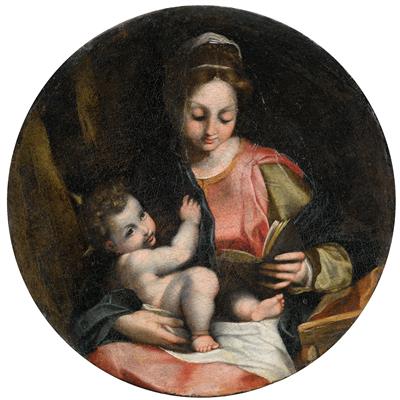Federico Barocci

(Urbino 1535–1612)
Madonna and Child,
oil on canvas, tondo, 41.5 cm, framed
Literature:
A. Emiliani, Federico Barocci (Urbino, 1535-1612), II, Ancona 2008, p. 368 no. 90.2
According to Andrea Emiliani the present painting is a later version of the Madonna with Child conserved in the Galleria Pallavicini in Rome (see literature). The Pallavicini version has been dated by Zeri to circa 1567 (see F. Zeri, La Galleria Pallavicini in Roma, 1959, p. 315) and compared to the Madonna di San Simone (Galleria Nazionale delle Marche, Urbino).
According to Olsen (see H. Olsen, Copenhagen 1962, p. 250 no. 82) the figure of the Madonna of the Pallavicini canvas is a variation of the Madonna di San Simone (Galleria Nazionale delle Marche, Urbino), while the child can be compared to the Madonna del Gatto (National Gallery, London).
The works produced by Barocci after his return to Urbino from Rome in 1563 reveals a stylistic move away from the complicated and elongated figure poses of central Italian Mannerism, as well as the colouristic and naturalistic richness of Venetian art, towards a more refined lyricism and delicacy. It remains a matter of conjecture whether Barocci travelled to Emilia to see Correggio’s altarpieces and frescoes, or whether he became familiar with Correggio’s work from cartoons and coloured drawings. It has been argued that Barocci adopted the psychological and painterly effects of Correggio’s work but achieved a more integrated effect.
As much as Barocci’s working methods earned him praise, they also exasperated the patience of patrons who awaited completion of orders. Due to an incurable illness that forced him to flee Rome in 1563, Barocci was only able to paint for one hour in the morning and one at night, spending the rest of the day drawing or in other pursuits. Duke Francesco-Maria II della Rovere, his principal patron, not only provided him with accommodation, but also acted as an intermediary with various clients, including Emperor Rudolf II, Pope Clement VII and King Philip II of Spain. The Grand Duke of Tuscany, Francesco I de’ Medici, tried to persuade him to abandon the court of Urbino for that of Florence, but Barocci was content to remain in Urbino with its strong artisan tradition and refined court life.
21.04.2015 - 18:00
- Odhadní cena:
-
EUR 100.000,- do EUR 150.000,-
Federico Barocci
(Urbino 1535–1612)
Madonna and Child,
oil on canvas, tondo, 41.5 cm, framed
Literature:
A. Emiliani, Federico Barocci (Urbino, 1535-1612), II, Ancona 2008, p. 368 no. 90.2
According to Andrea Emiliani the present painting is a later version of the Madonna with Child conserved in the Galleria Pallavicini in Rome (see literature). The Pallavicini version has been dated by Zeri to circa 1567 (see F. Zeri, La Galleria Pallavicini in Roma, 1959, p. 315) and compared to the Madonna di San Simone (Galleria Nazionale delle Marche, Urbino).
According to Olsen (see H. Olsen, Copenhagen 1962, p. 250 no. 82) the figure of the Madonna of the Pallavicini canvas is a variation of the Madonna di San Simone (Galleria Nazionale delle Marche, Urbino), while the child can be compared to the Madonna del Gatto (National Gallery, London).
The works produced by Barocci after his return to Urbino from Rome in 1563 reveals a stylistic move away from the complicated and elongated figure poses of central Italian Mannerism, as well as the colouristic and naturalistic richness of Venetian art, towards a more refined lyricism and delicacy. It remains a matter of conjecture whether Barocci travelled to Emilia to see Correggio’s altarpieces and frescoes, or whether he became familiar with Correggio’s work from cartoons and coloured drawings. It has been argued that Barocci adopted the psychological and painterly effects of Correggio’s work but achieved a more integrated effect.
As much as Barocci’s working methods earned him praise, they also exasperated the patience of patrons who awaited completion of orders. Due to an incurable illness that forced him to flee Rome in 1563, Barocci was only able to paint for one hour in the morning and one at night, spending the rest of the day drawing or in other pursuits. Duke Francesco-Maria II della Rovere, his principal patron, not only provided him with accommodation, but also acted as an intermediary with various clients, including Emperor Rudolf II, Pope Clement VII and King Philip II of Spain. The Grand Duke of Tuscany, Francesco I de’ Medici, tried to persuade him to abandon the court of Urbino for that of Florence, but Barocci was content to remain in Urbino with its strong artisan tradition and refined court life.
|
Horká linka kupujících
Po-Pá: 10.00 - 17.00
old.masters@dorotheum.at +43 1 515 60 403 |
| Aukce: | Obrazy starých mistrů |
| Typ aukce: | Salónní aukce |
| Datum: | 21.04.2015 - 18:00 |
| Místo konání aukce: | Wien | Palais Dorotheum |
| Prohlídka: | 11.04. - 21.04.2015 |
